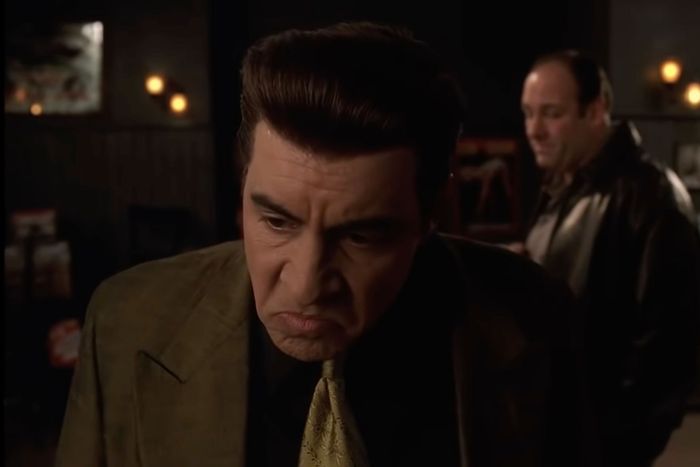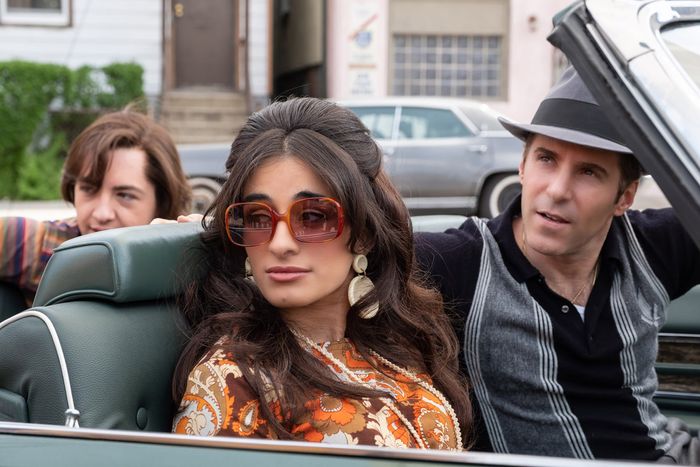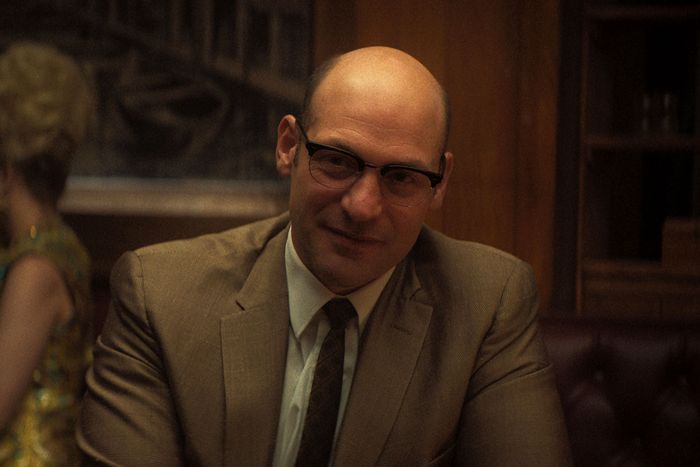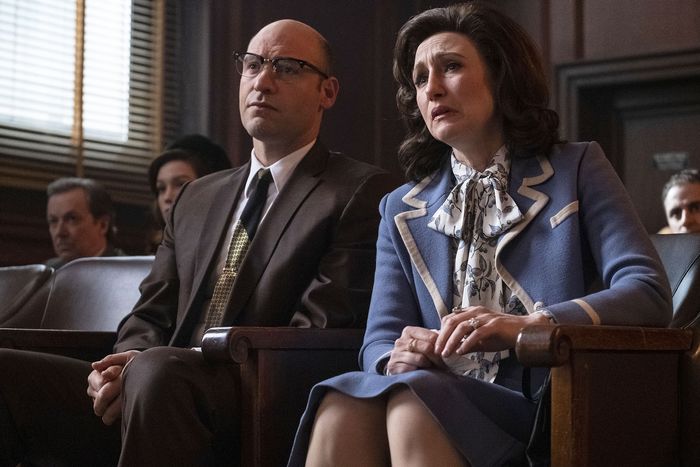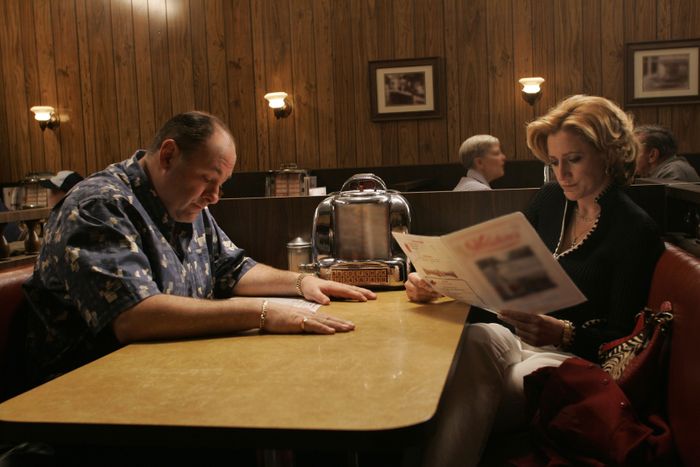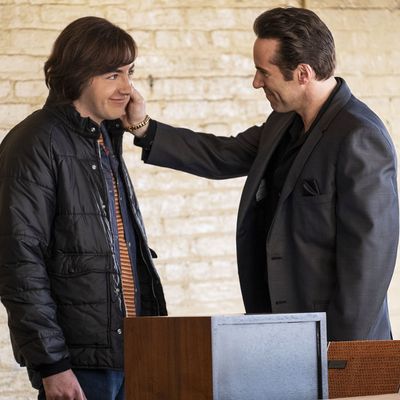
The creators of The Many Saints of Newark: A Sopranos Story wanted to create a two-hour crime drama that could stand apart from The Sopranos, but let’s be real: It’s a prequel to an existing series, and it will be treated as such by most people who watch it.
Nevertheless, as someone who unironically calls himself “a student of The Sopranos” — I co-wrote a whole book on the show with Alan Sepinwall, who used to cover it with me at The Star-Ledger, the newspaper Tony Soprano read at breakfast — I found the movie fascinating because it detaches series creator David Chase’s characters from their original context and treats them as mythology that can be retold, reinterpreted, and revised.
Set in the late 1960s and early 1970s, The Many Saints is an alternative take on The Sopranos by a handful of the series’ founding artists, exploring the relationship between young Tony Soprano (Michael Gandolfini) and a legendary character who was talked about but never seen: Tony’s uncle, the charismatic and terrifying Newark mobster Dickie Moltisanti (Alessandro Nivola). Some of the embellishments and additions to the existing narrative are fun but marginal. Others fundamentally alter our relationship to the show if we decide to accept them at face value.
That we don’t have to accept them is another thing that makes this project fascinating. The tale is told by a deeply unreliable narrator: the late Christopher Moltisanti, Tony’s future protégé and Dickie’s only son, a device that Chase & Co. settled on during reshoots after they decided that previous attempts at framing devices — involving Tony’s wife, Carmela (Edie Falco), and his fussy captain, Paulie Walnuts (Tony Sirico) — weren’t quite what they wanted. Going with Carmela or Paulie would’ve resulted in a subjective, first-person recounting of the past as well. But making Christopher the narrator raises cosmic questions that go far beyond whether the storyteller is getting basic facts right. Not only was Chrissy never much of a fact-checker (he mangled everything from movie quotes to historical tidbits), he also has a posthumous blood grudge against many of the people depicted in the story.
Can ghosts talk to each other? What are his sources?
But I digress. Here, my seven obsessions with the echoes between the series and The Many Saints of Newark.
Do not read on unless you’ve seen The Many Saints and all of The Sopranos.
Silvio Dante’s, uh, hair
When Steven Van Zandt played Tony’s consigliere, Silvio Dante, on the original series, the costume department fitted him with a towering, shiny pompadour. Even if you hadn’t seen pictures of Van Zandt offscreen with a headscarf, you’d take one look at that thing on Silvio’s dome and know it was glued on.
Thing is, though, the series never addressed whether Silvio wore a hairpiece. This, to me, was as much a troll of the audience as the writers not telling us what happened to the Russian from “Pine Barrens” — grander in scope, honestly, because we had to look at Silvio’s head every week.
In conversations for a New York Magazine piece, Chase told me that the question of whether Silvio’s hair was organic or artificial never came up when they were making the show. “I don’t think we established it one way or the other,” he said. The most logical assumption is that nobody commented on the hairpiece because Silvio was sensitive about it, and if anyone was foolish enough to violate that taboo, they might end up in “witness protection” like Richie Aprile and Ralphie Cifaretto.
In Saints, though, a toupee is a toupee. John Magaro inherited the role from Van Zandt — perfect casting, as he got to study Van Zandt up close while starring in Chase’s film Not Fade Away, a period piece that employed Van Zandt as music supervisor and performance coach. Magaro sold Chase on a comic subplot that wasn’t in the original Saints script: As the movie unfolds over the course of many years, we see Silvio gradually losing his hair from a scalp disease, becoming hypersensitive about it and then acquiring the toupee, which is revealed as fake thanks to a slapstick mishap during the interrogation of a rival gang member. (In real life, Van Zandt suffered scalp damage in a car accident and lost his ability to grow a full head of hair.)
So does this mean Silvio’s hair is canonically a fugazi? Not necessarily. Remember, the series showed Silvio sporting a swept-back Brylcreem’d ’do at all times, even when relaxing in bed next to his wife or in a coma in an intensive-care unit after being shot. Either the show’s incarnation of Silvio had real hair that looked fake or else he wore a hairpiece from the late 1960s through the early aughts and was so vain that he told the EMTs to leave the toupee on as he was loaded into the back of an ambulance. If we accept the Saints hairpiece subplot as canon — i.e., as definitive proof of the pompadour’s fakeness — it means that Silvio’s primary duty, more than serving the family, more than protecting his own life or that of his loved ones, was preserving the illusion of his dignity.
I kinda like that version better. A mobster who’s so sensitive about his lack of hair that he won’t take his rug off even after he’s been shot seems like the kind of mobster we’d meet on The Sopranos.
I also like to wonder if Christopher, who was regularly condescended to by Silvio, is lying to us about the rug to embarrass Sil. Or figuring that when you’re dead, there are no more secrets.
A corrupting father figure
On the series, Dickie was described (by Tony, mainly) as a legendary, heroic figure, a mobster that other mobsters aspired to be. The Many Saints of Newark establishes that Dickie was an impulsive, lustful, unpredictable, violent psychopath capable of murdering his own father and taking his father’s young wife, Giuseppina, as his goomar, then killing her, too.
Granted, The Sopranos rarely revealed that a character you thought you knew was nicer than you originally thought, so it’s not a shock to learn that Dickie was another monster in a town full of them. No, what’s interesting is how the film’s detailed portrait of Dickie resonates with what we already know about the mantle of mentorship that passes from Dickie to Tony. That story is about a succession of cursed father-son relationships recurring across generations: the Overlook Hotel by way of Bergen County.
Check this out: Dickie Moltisanti dies before his son, Christopher, can know him, after corrupting Tony, the young man who will become his son Christopher’s surrogate father and mentor. Decades later, Tony exploits and corrupts Christopher, then kills him before Christopher’s daughter has a chance to know her dad.
It’s suggested in the film that sometimes babies are born with knowledge from the other side. That would explain why little Christopher cries when Uncle Tony is near.
What if Christopher’s death in 2006 is long-delayed karmic retribution against Dickie for his obscene crimes? The final link in a chain of woe?
A tale of two (mother)fuckers
Speaking of obscenity: Dickie is the Oedipus Rex of Newark gangsters, a beast who killed his own father and entered into a sexual relationship with his (step)mother, the immigrant Giuseppina. In The Many Saints of Newark, Dickie drowns Giuseppina after she confesses to cuckolding him. It’s a symbolic matricide against a woman half the murderer’s age.
Dickie’s surrogate son, Tony, has Oedipal impulses too. Where Dickie enacts his urges, Tony denies them. Dr. Melfi tells Tony that his most powerful sexual attractions are to women who remind him of his mother. Tony is disgusted by the insinuation, but his parade of girlfriends and crushes proves Melfi was right. The most vivid example is Gloria Trillo (Annabella Sciorra), who arrives in Melfi’s lobby weeks after Livia’s death as if summoned by dark magic. Tony’s rage is triggered when Gloria uses his mother’s catchphrase, “Poor you!” Her expressions and intonations sometimes make it seem as if Livia is speaking through her.
The echoes don’t end there. Vera Farmiga’s performance as young Livia often seems like it’s channeling both Nancy Marchand and Falco, which subtly signals that in addition to having affairs with women who remind Tony of some aspect of his mother, he also married one.
Now look at the patterning of the violence in the Moltisanti-Soprano universe. Asphyxiation is the preferred way to kill somebody who represents a psychic, as well as physical or legal, threat. Dickie drowns Giuseppina in the ocean. Tony Soprano, Dickie’s pet project, is a prodigious asphyxiator. He tries to suffocate his own mother in season one, shortly after killing a mob informant by (you guessed it) strangulation. Two seasons later, Tony tries to kill his girlfriend, Gloria, who is characterized as an incarnation of Livia, by strangling her on the floor of her house. Tony kills his nemesis Ralphie by strangling him and then beating his head against the floor. Five years later, he asphyxiates Christopher by pinching his nose and mouth shut after a car wreck, drowning him in his own blood.
It’s as if, after Dickie’s death, a part of his spirit passed to Tony in a David Lynchian transference of vileness. Maybe Dickie is the strangler inside Tony. Maybe when Tony tries to suffocate Livia and strangle Gloria, and succeeds in asphyxiating Christopher, it’s Dickie’s spirit guiding his hands. In a sense, Dickie already killed his own son by corrupting Tony. Tony’s asphyxiation of Christopher makes the metaphorical literal.
Absurd? Not if you watched the show. The Sopranos was quite comfortable intimating a world beyond the one we inhabit. Christopher’s first and only success as a filmmaker was Cleaver, a horror flick about a murdered mobster exacting revenge on a Tony Soprano–like gang boss. Strangler could have been a sequel to Cleaver: a film in which the demonic spirit of Dickie possesses another mobster’s hands and uses them to kill.
The identity of Dickie’s killer
It’s Junior. Of course it’s Junior.
If there’s one thing we knew about Corrado “Junior” Soprano, it’s that he’ll order the murder of anyone for any reason, no matter how petty. Junior orders Dickie’s death as revenge for Dickie laughing at his fall on the steps of a church, an accident that put Junior in a back brace. Of course, the crime is blamed on a Black man — in this case, Harold McBrayer (Leslie Odom Jr.), a former numbers runner for Dickie — because that has always been one of the preferred Mafia methods of escaping blame for crimes.
It’s an inverted rhyme with the series: In season one of The Sopranos, Junior orders Dickie’s surrogate son, Tony, whacked in order to curry favor with Livia and hires two Black gunmen to kill Tony; they fail. Thirty years earlier, Black gunmen (led by Harold McBrayer) attempt to kill Dickie; Harold lets Dickie go the instant he gets him where he wants him — a power move, like a cat trapping a mouse and then releasing it. Both showdowns happen on public streets and involve shattered auto glass and a runaway car. Later in the movie, a gunman hired by Junior kills Dickie. As surely as the sun rises in the east, the crime will be blamed on Harold.
Livia’s pills and the Sopranos’ mental health
In the film, Tony knows Livia has mental-health issues, even if he doesn’t describe them as such. That’s why Tony asks Dickie to bring him samples of the antidepressant Elavil to give to Livia: He thinks it will improve her mood, and her life, and make it possible for her to express love. The scene in which Livia tells the high-school guidance counselor how much Tony loved the time she stayed up all night and read to him hints at the mother that Livia could have been more often if she’d had medicinal and/or therapeutic help.
If Tony knew, even subconsciously, that Livia had mental-health problems, it ought to change our perception of scenes in the show in which Melfi steers Tony to recognize his mother’s condition and relate it to his own problems. Even in the mental-health-unenlightened 1970s, a smart kid like Tony would have understood that if his mom had certain issues, he could have them too, and he would’ve carried this knowledge into therapy, even if it was buried deeper than the corpses of the Meadowlands.
But in the series, Tony never entertains this possibility, no matter how skillfully Melfi maneuvers him toward it. Even after he takes her suggestion and gets on a newer antidepressant, Prozac, he still resists the idea that there could be something chemically wrong with a person’s brain, just as there could be something wrong with their hips or heart.
Post–The Many Saints rewatches of The Sopranos will make it seem as if Tony is even deeper in denial than we originally thought.
The haunting of Holsten’s
Yes, Holsten’s: the site of the controversial last scene of the series.
Let’s put the meaning of the cut to black aside for a moment and ask a different question: Why does Tony keep looking up at the sound of the ringing bell above the door?
Yeah, sure, he’s wondering when his daughter, Meadow, will get there. And yeah, sure, he’s a gangster, so he’s wired to watch the door because you never know who might come through it. And yes, the bell is itself a loaded symbol: “Bring out your dead,” “Ask not for whom the bell tolls,” etc.
But now it’s not just a location. It’s a significant location. A haunted one.
Chase has repeatedly said that the point of the last scene is not about whether Tony lives or dies but to spur reflection “about death” and how life is precious and can be ripped from us at any moment. The Many Saints of Newark refines that idea.
When we rewatch the show now, we might think when the adult Tony is constantly checking the front door of Holsten’s that he might be looking for Dickie as well as Meadow. The scene is still “about death,” but maybe Tony’s mind is more focused on one death than on the others he’s experienced or caused: Dickie’s.
If, indeed, the finale of The Sopranos is a subjective moment filtered through Tony’s brain, as some have argued, then it makes more aesthetic and dramatic sense now. Most of the Soprano family’s enemies have been eliminated at that point in the show, so there’s no obvious reason for the tension to be cranked up so high. But this is a man who has panic attacks. It makes sense that Tony might be experiencing symptoms while sitting in the restaurant where he was supposed to meet his surrogate father on the day he was killed.
I’m not saying that Chase, Lawrence Konner, director Alan Taylor & Co. set another pivotal scene at Holsten’s just to change the conversation about The Sopranos’ ending. But that’s going to be one of the outcomes. And I’m all for it.
Now, whenever anyone asks, “What was that final scene about?,” there’s one more plausible answer that’s actually supported by the text — a belated appendix but still the text.
Maybe Tony lived. Maybe he died. Maybe he had a panic attack and blacked out. Or maybe he was just sitting there thinking about death, his heart racing (thus the tension) because this is the place he went to in the early ’70s — right around Christmastime, just like in the final episode of the show — to meet a father figure who never showed up.
Maybe that’s why, when the Soprano family orders onion rings, they eat them like holy wafers, as a sacrament.
Tony’s “Rosebud” moment
If you think about everything that happens on the show and in the film and then consider the significance of both Holsten’s scenes, the one in the film feels like a “Rosebud moment,” as in Citizen Kane. This feels especially apt if you consider The Sopranos the Citizen Kane of American TV drama, and if you know of the esteem in which Chase holds Kane’s director-star, Orson Welles. When Carmela started a film club, one of the films she screened was Citizen Kane, prompting Adriana’s perfect two-sentence review: “So it was the sled, huh? He shoulda told somebody.”
That’s a marvelous joke, and not just on viewers who insist the final scene of the show could only mean one thing. In Citizen Kane, we find out in the final scene that Rosebud was Kane’s boyhood sled, and it burns up in a furnace before we can get a good look at it. Welles never intended for that shot to actually “explain” the character of Charles Foster Kane; it was more of a way to poke fun at stories in which one fact unlocks the mysteries of a character’s personality.
That being said, the sled is still crucial to Citizen Kane, but not because the object answers a riddle or completes a puzzle. It’s important because it’s at the center of the most wrenching scene, the one in which young Kane is separated from his mother — a moment that doesn’t fully explain Kane but marks a moment when his development could’ve gone a different way but didn’t. Cut off from his mother, he spent the rest of his life trying to make the world love him. Two roads diverged — and who knows? If he had stayed with his mom, maybe he would have grown up to be a novelist or a sled-maker.
The Holsten’s scenes in The Many Saints of Newark serve a similar function for Tony’s character. On a cold December day, two roads diverged. That was the day that Tony lost his father and his mother. The “father” was his surrogate dad, Dickie. In Dickie’s pocket were antidepressants that might’ve changed the lives of Livia, Tony, and his sisters, not to mention everyone else who would feel Livia’s wrath. Livia was lost that day, in a sense, to her demons.
The paranoid, conniving, emotionally constipated, ultimately demented Livia we met on the show might never have existed if Dickie had lived. If Dickie had lived and sat down with Tony at Holsten’s to split a basket of onion rings, The Sopranos might’ve been a heartwarming, uplifting comedy about a happy family of do-gooders that was born into a world of crime but escaped it. And it might have been called The Many Saints of Newark.
Of course, Christopher, the one who gave us all this new information, thinks the first man on the moon was named Neil Young, so maybe we should write the whole thing off as untrustworthy alternative fiction. Or self-reflexive fanfiction invented by the original artists. Either way, I like the idea of Sopranos stories being quasi-mythic accounts of incidents that will play differently and mean different things depending on who’s telling the story. There are elisions, embellishments, misdirections, lies — because in this world, stories are still mainly passed down verbally, and the storytellers tend to be self-flattering.
I also like the idea of a movie reaffirming that the Sopranos characters are just that: characters. Words on a page. Constructs that can be reinterpreted, recontextualized, and reinvented in other contexts, some of them wildly unlike the one in which we first encountered them. This notion reminds me of George Miller telling reporters that he always saw the Mad Max films not as one continuous, linear story but as a bunch of disconnected campfire tales about a mythic hero, a Robin Hood or an Odysseus of the wasteland. So it doesn’t matter who plays Max, just like it doesn’t matter who plays Miss Marple, James Bond, or Philip Marlowe, as long as the actors are good and the storytellers have a vision and aren’t just doing it to fill the content maw.
Chase & Co. could pull a Mad Max and do another Sopranos story with yet another cast and set it in the present. Or they could set it in the 1940s and populate it with a whole new batch of characters. Or they could do Cleaver at full length and play it straight, the way Christopher would’ve wanted it (Rob Zombie would nail it). New entries wouldn’t have to follow the Marvel/Star Wars playbook and smoosh the work down until it fits into a predesigned aesthetic box. Chase created a big world. There’s room to dream.



